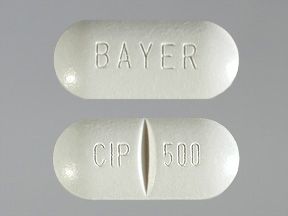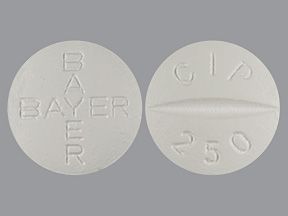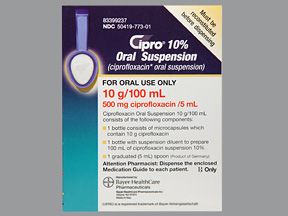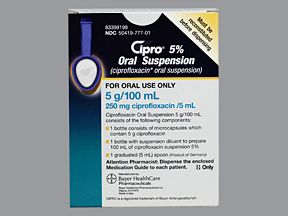Cipro (ciprofloxacin) is a brand-name drug prescribed for certain bacterial infections in adults and some children. Cipro comes in several forms and is typically taken every 12 hours. The dosage can vary depending on what it’s treating.
The Food and Drug Administration (FDA) has approved Cipro to treat certain bacterial infections in adults and some children. These include urinary tract infections (UTIs), pneumonia, and more.
Cipro belongs to a class of antibiotics called fluoroquinolones. It comes in several forms, including oral tablets, a liquid suspension, eye drops, eardrops, and injections. This article covers the oral tablet and oral liquid suspension forms of Cipro. For information about the other forms, talk with your doctor.
Cipro is available in a generic version called ciprofloxacin.
Keep reading for information about the antibiotic dosage of Cipro, including its strengths and how to take the drug. For a comprehensive look at Cipro, see this article.
Note: This article describes typical dosages for Cipro provided by the drug’s manufacturer. When taking Cipro, always follow the dosage prescribed by your doctor.
Your doctor will prescribe the correct form and dosage of Cipro based on the condition you are taking it to treat. For more information on how doctors determine the right dosage, see the “Factors that can affect your dosage” section below.
Cipro forms
This article covers two forms of Cipro that you swallow. They are as follows:
- liquid suspension*
- oral tablet†
* A liquid suspension is a type of liquid mixture. Your pharmacist makes it by mixing the active ingredient with a liquid.
† An extended-release oral tablet form of Cipro known as Cipro XR has been discontinued by the drug’s manufacturer. (“Extended release” means the drug is released slowly over time in the body.)
Cipro strengths
Cipro liquid suspension comes in the following strengths, measured as milligrams (mg) per milliliter (mL):
- 250 mg/5 mL
- 500 mg/5 mL
Cipro tablets come in the following strengths:
- 250 mg
- 500 mg
Typical dosages
The following information describes dosages that are commonly used or recommended in adults. However, be sure to take the dosage your doctor prescribes for you. Your doctor will determine the best dosage to fit your needs.
Dosage for urinary tract infection (UTI)
The typical adult dosage for a UTI, such as a bladder infection, depends on the drug form and the severity of the infection.*
The usual dosage is as follows:
- Dose: 250 mg to 500 mg Cipro tablet or liquid suspension
- Frequency: every 12 hours
- Length of treatment: 3 to 14 days
* To learn more about Cipro and UTI severity, see the “Factors that can affect your dosage” below.
Dosage for lower respiratory infection, such as pneumonia or bronchitis
The typical adult dosage for lower respiratory infection (an infection of the lungs or bronchial tubes) is as follows:
- Dose: 500 mg to 750 mg Cipro tablet or liquid suspension
- Frequency: every 12 hours
- Length of treatment: 7 to 14 days
Dosage for bacterial skin infection
The typical adult dosage for bacterial skin infections is as follows:
- Dose: 500 mg to 750 mg Cipro tablet or liquid suspension
- Frequency: every 12 hours
- Length of treatment: 7 to 14 days
Dosage for gonorrhea
The typical adult dose for gonorrhea (a sexually transmitted infection) is 250 mg Cipro tablet or liquid suspension. You’ll take this dose one time.
Dosage for abdominal infection
The typical adult dosage for abdominal infection, such as diverticulitis (infected pouches along the wall of the colon), is as follows:
- Dose: 500 mg Cipro tablet or liquid suspension
- Frequency: every 12 hours
- Length of treatment: 7 to 14 days
Dosage for chronic prostatitis caused by certain bacteria
The typical adult dosage for chronic prostatitis infection (an infection of the prostate gland) is as follows:
- Dose: 500 mg Cipro tablet or liquid suspension
- Frequency: every 12 hours
- Length of treatment: 28 days
Dosage for joint and bone infection
The typical adult dosage for joint infection and bone infection is as follows:
- Dose: 500 mg to 750 mg Cipro tablet or liquid suspension
- Frequency: every 12 hours
- Length of treatment: 4 to 8 weeks
Dosage for typhoid fever
The typical adult dosage for typhoid fever (an infection caused by Salmonella bacteria) is as follows:
- Dose: 500 mg Cipro tablet or liquid suspension
- Frequency: every 12 hours
- Length of treatment: 10 days
Dosage for diarrhea caused by certain bacteria
The typical adult dosage for diarrhea caused by a bacterial infection is as follows:
- Dose: 500 mg Cipro tablet or liquid suspension
- Frequency: every 12 hours
- Length of treatment: 5 to 7 days
Dosage for sinus infection
The typical adult dosage for sinus infection (bacterial infection of one or more sinuses) is as follows:
- Dose: 500 mg Cipro tablet or liquid suspension
- Frequency: every 12 hours
- Length of treatment: 10 days
Dosage for plague
The typical adult dosage for plague (a disease caused by the bacterium Yersinia pestis) is as follows:
- Dose: 500 mg to 750 mg Cipro tablet or liquid suspension
- Frequency: every 12 hours
- Length of treatment: 14 days
Dosage for exposure to anthrax
The typical adult dosage for exposure to anthrax (a dangerous infection caused by the bacterium Bacillus anthracis) is as follows:
- Dose: 500 mg Cipro tablet or liquid suspension
- Frequency: every 12 hours
- Length of treatment: 60 days
Children’s dosage
The Cipro tablet and liquid suspension are approved to treat certain bacterial infections in children. Doctors base the dosage on a child’s body weight in kilograms (kg). For reference, 1 kg is about 2.2 pounds (lb). The dosages below are in milligrams per kilogram (mg/kg). Your child’s doctor will determine their dosage.
Dosage for serious urinary tract infection (UTI) or kidney infection
The typical children’s dosage for a complicated UTI,* such as a kidney infection, is as follows:
- Dose: 10 mg/kg to 20 mg/kg Cipro tablet or liquid suspension
- Frequency: every 12 hours
- Length of treatment: 10 to 21 days
The maximum amount per dose is 750 mg.
* To learn more about Cipro for complicated UTIs, see the “Factors that can affect your dosage” section below.
Dosage for exposure to anthrax
The typical children’s dosage for exposure to anthrax is as follows:
- Dose: 15 mg/kg Cipro tablet or oral suspension
- Frequency: every 12 hours
- Length of treatment: 60 days
The maximum amount per dose is 500 mg.
Dosage for plague
The typical children’s dosage for plague is as follows:
- Dose: 15 mg/kg Cipro tablet or liquid suspension
- Frequency: every 8 to 12 hours
- Length of treatment: 14 days
The maximum amount per dose is 500 mg.
Below are some common questions related to Cipro’s dosage.
What is the Cipro dosage for UTI? Is the dosage for UTI different for older adults?
The Cipro dosage for a urinary tract infection (UTI) depends on the severity of the infection and other factors. For example, the dosage may differ for older adults (ages 65 years and older) who have reduced kidney function.
A UTI in a person with reduced kidney function or a kidney infection is an example of a complicated UTI. The other type is a simple UTI. For details, see the “Factors that can affect your dosage” section below.
To view Cipro’s recommended dosage for UTIs, see the “Cipro dosage” section above. If you’d like to know more about Cipro dosages in older adults, talk with your doctor.
Does Cipro come as ear drops? If so, what is the dosage?
Yes, Cipro comes as otic drops (ear drops). The dosage depends on the product. Forms of Cipro ear drops include:
- otic solution (Cetraxal)
- otic suspension (Otiprio)
- otic suspension of Cipro in combination with dexamethasone (Ciprodex)
- otic suspension of Cipro in combination with hydrocortisone (Cipro HC)
For more information about Cipro ear drops and dosages, talk with your doctor or pharmacist.
Are Cipro eye drops available? What is the typical dose for eye drops?
Cipro comes as an ophthalmic drop (eye drops). The dose depends on the condition being treated. Cipro eye drops are used to treat eye ulcers (open sores on the eye) or bacterial conjunctivitis (commonly called pink eye).
If you’d like to know more about Cipro eye drops, talk with your doctor or pharmacist.
Can Cipro be used for strep throat? What is the dosage for strep throat?
Cipro may be used to treat strep throat, but it’s typically not the first treatment option.
For questions about the best treatment for strep throat, talk with your doctor. If they recommend Cipro, they’ll determine the right dosage for you.
The Cipro dosage your doctor prescribes will depend on several factors. These include:
- the type and severity of the condition you’re taking Cipro to treat
- the form of Cipro you take
- your age
Other medical conditions you have can also affect your Cipro dosage.
Dosage adjustments
Your doctor may need to adjust your Cipro dosage if you have kidney disease. This may mean taking a lower dose or taking the drug less often.
To learn about typical recommended dosages for Cipro’s uses, see the “Cipro dosage” section above.
Cipro dosage for simple vs. complicated urinary tract infection (UTI)
If your doctor recommends Cipro for a UTI, your dosage depends on whether it’s simple or complicated. A simple UTI involves only the bladder and urethra (the tube that carries urine out of the body).
A simple UTI doesn’t have any associated risk factors, such as pregnancy, that can make treatment difficult or worsen the outcome.
Factors that can complicate a UTI include the following:
- being male*
- fever
- reduced kidney function
- infection involving either the kidney or another organ
- low immune system function
- urinary catheter use
- pregnancy
All UTIs in males and in people who are pregnant are complicated. A kidney infection is another example of a complicated UTI.
If you have questions about your Cipro dosage or treatment plan, ask your doctor.
* Sex and gender exist on spectrums. Use of the terms “male” and “female” in this article refers to sex assigned at birth.
Cipro comes in forms that you swallow. (To learn more about Cipro’s forms, see the “Cipro dosage” section above.)
Always take Cipro exactly as your doctor prescribes. Your symptoms will likely ease before you finish your prescription. However, it’s important to finish the entire treatment with Cipro even if you feel better. If you stop taking the drug early, the infection may come back and be harder to treat.
You’ll swallow Cipro tablets whole or split them in half along the score line (the line running across the tablet).
If you have trouble swallowing tablets, see this article for tips on how to take this form of medication. You can also talk with your doctor or pharmacist.
For the liquid suspension form of Cipro, shake the bottle for about 15 seconds before pouring your dose. This ensures that it’s mixed well.
Cipro dose timing
It may be helpful to take Cipro around the same time each day. This helps maintain a steady level of the drug in your body so Cipro can work effectively. Depending on your prescription, this may mean taking one dose in the morning and evening at the same time each day.
Cipro with water, food, and other medications
Be sure to drink plenty of water and other fluids while you’re taking Cipro.
You can take Cipro with or without food. You should not take Cipro with dairy products or calcium-fortified juices alone. However, you can take Cipro with a complete meal that contains these products.
If you take vitamin supplements or other medications, ask your doctor or pharmacist about taking them with Cipro. Some medications and supplements need to be taken at different times of day than Cipro. Doing so helps reduce the risk of drug interactions. (To learn more about Cipro interactions, you can view this article.)
ACCESSIBLE DRUG LABELS AND CONTAINERSSome pharmacies offer labels with large print, braille, or a code you scan with a smartphone to convert text to speech. If your local pharmacy doesn’t have these options, your doctor or pharmacist might be able to recommend a pharmacy that does.
If you’re having trouble opening medication bottles, ask your pharmacist about putting Cipro in an easy-open container. They also may recommend tools that can make it easier to open bottles.
If you miss a dose of Cipro, take it as soon as you remember. However, if there are less than 6 hours until your next regularly scheduled dose, skip the missed dose. Then, take the next dose at the regular time.
Do not take two doses of Cipro at one time. This can cause serious side effects.* (For information about Cipro side effects, see this article.)
If you’re unsure whether to take or skip a dose of Cipro, talk with your doctor or pharmacist.
To help make sure that you don’t miss a dose, try using a medication reminder. This can include setting an alarm or using a timer. You could also download a reminder app on your phone.
* Cipro has a boxed warning for the risk of serious side effects. A boxed warning is the most serious warning from the Food and Drug Administration (FDA). A boxed warning alerts doctors and patients about drug effects that may be dangerous. To learn more, see “Boxed warnings” at the beginning of this article.
It’s important that you do not use more Cipro than your doctor prescribes. For some medications, taking more than the recommended amount may lead to side effects or overdose.* For information about Cipro side effects, see this article.
* Cipro has a boxed warning for the risk of serious side effects. A boxed warning is the most serious warning from the Food and Drug Administration (FDA). A boxed warning alerts doctors and patients about drug effects that may be dangerous. To learn more, see “Boxed warnings” at the beginning of this article.
If you take more than the recommended amount of Cipro
Call your doctor right away if you believe you’ve taken too much Cipro. Another option is to call America’s Poison Centers at 800-222-1222 or use its online tool. If you have severe symptoms, immediately call 911 or your local emergency number, or go to the nearest emergency room.
The dosages in this article are typical dosages provided by the drug’s manufacturer. If your doctor recommends Cipro for you, they will prescribe the dosage that’s right for you. Always follow the dosage that your doctor prescribes.
As with any drug, never change your dosage of Cipro without your doctor’s recommendation. If you have questions about the dosage of Cipro that’s best for you, talk with your doctor.
Besides learning about dosage, you may want other information about Cipro. These additional articles might be helpful:
- More about Cipro: For information about other aspects of Cipro, refer to this article.
- Side effects: To learn about side effects of Cipro, see this article. You can also look at the drug’s prescribing information.
- Interactions: For details about what Cipro interacts with, see this article.
- Details about infection: To learn about how Cipro is used to treat UTIs, see this article. For details about infection, see our list of articles on infectious diseases, bacteria, and viruses.
Disclaimer: Medical News Today has made every effort to make certain that all information is factually correct, comprehensive, and up to date. However, this article should not be used as a substitute for the knowledge and expertise of a licensed healthcare professional. You should always consult your doctor or another healthcare professional before taking any medication. The drug information contained herein is subject to change and is not intended to cover all possible uses, directions, precautions, warnings, drug interactions, allergic reactions, or adverse effects. The absence of warnings or other information for a given drug does not indicate that the drug or drug combination is safe, effective, or appropriate for all patients or all specific uses.




